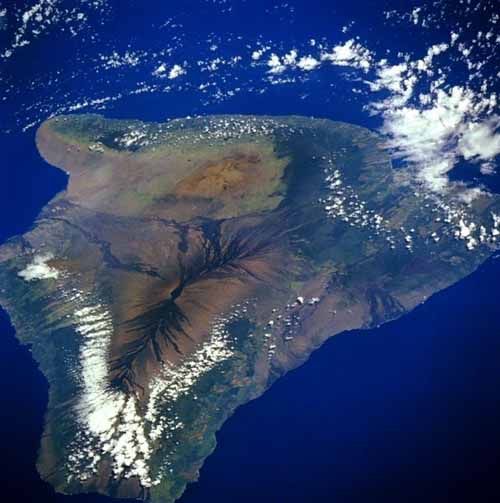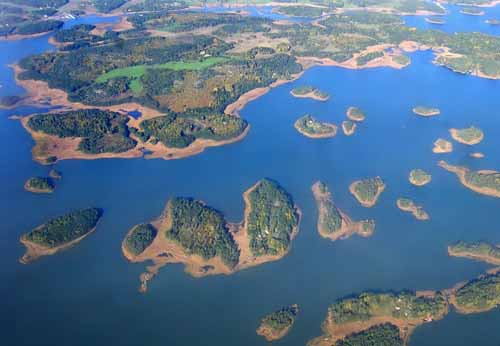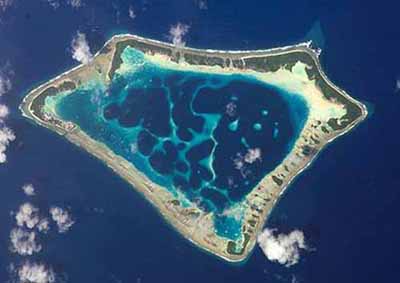

An island, or isle, is any piece of land that is surrounded by water. Very small islands such as emergent land features on atolls are called islets. A key or cay is another name for a small island or islet. An island in a river or lake may be called an eyot.
There are two main types of islands: continental islands and oceanic islands. There are also artificial islands. A grouping of geographically and/or geologically related islands is called an archipelago.

The word island comes from Old English igland (from 'ig', similarly meaning 'island' when used independently, and -land carrying its contemporary meaning). However, the spelling of the word was modified in the 15th century by association with the etymologically unrelated Old French loanword isle, which itself comes from the latin word insole.
There is no standard of size which distinguishes islands from islets and continents.
When defining islands as pieces of land that are surrounded by water, narrow bodies of water like rivers and canals are often, but not always, left out of consideration. For instance, in France the Canal du Midi connects the Garonne river to the Mediterranean Sea, thereby completing a continuous water connection from the Atlantic Ocean to the Mediterranean Sea. So technically, the land mass that includes the Iberian Peninsula and the part of France that is south of the Garonne River and the Canal du Midi is surrounded by water.
For a completely natural example, the Orinoco River splits into two branches near Tamatama, in Amazonas state, Venezuela. The southern branch flows south and joins the Rio Negro, and then the Amazon. Thus, all of the Guianas (Guyana, Suriname, and French Guiana) and substantial parts of Brazil and Venezuela are surrounded by (river or ocean) water. These instances are not generally considered islands. However, small pieces of land bordered by rivers are considered islands.
This also helps explain why Africa-Eurasia can be seen as one continuous landmass (and thus technically the biggest island): generally the Suez Canal is not seen as something that divides the land mass in two. The mainland of Australia is often considered the largest island because it is covered on all sides by water while not being connected to another body of land.
On the other hand, an island may still be described as such despite the presence of a land bridge, e.g., Singapore and its causeway or the various Dutch delta Islands, such as IJsselmonde.
Some places may even retain "island" in their names after being connected to a larger landmass by a wide land bridge, such as Coney Island. The retaining of the island description may therefore be to some degree simply due to historical reasons - though the land bridges are often of a different geological nature (for example sand instead of stone), and thus the islands remain islands in a more scientific sense as well.
Continental islands are bodies of land that lie on the continental shelf of a continent. Examples include Greenland and Sable Island off North America; Barbados and Trinidad off South America; Great Britain, Ireland and Sicily off Europe; Sumatra, Borneo and Java off Asia; and New Guinea, Tasmania and Kangaroo Island off Australia.
A special type of continental island is the microcontinental island, which results when a continent is rifted. Examples are Madagascar and Socotra off Africa; New Zealand; the Kerguelen Islands; and some of the Seychelles.
Another subtype is an island or bar formed by deposition of tiny rocks where a water current loses some of its carrying capacity. An example is barrier islands, which are accumulations of sand deposited by sea currents on the continental shelf. Another example is islands in river deltas or in large rivers. While some are transitory and may disappear if the volume or speed of the current changes, others are stable and long-lived. Islets are very small islands.
Oceanic islands are ones that do not sit on continental shelves. The vast majority are volcanic in origin. The few oceanic islands that are not volcanic are tectonic in origin and arise where plate movements have lifted up the deep ocean floor to above the surface. Examples of this include Saint Peter and Paul Rocks in the Atlantic Ocean and Macquarie Island in the Pacific.
One type of volcanic oceanic island is found in a volcanic island arc. These islands arise from volcanoes where the subduction of one plate under another is occurring. Examples include the Mariana Islands, the Aleutian Islands and most of Tonga in the Pacific Ocean. Some of the Lesser Antilles and the South Sandwich Islands are the only Atlantic Ocean examples.
Another type of volcanic oceanic island occurs where an oceanic rift reaches the surface. There are two examples: Iceland, which is the world's second largest volcanic island, and Jan Mayen - both are in the Atlantic.
A third type of volcanic oceanic island is formed over volcanic hotspots. A hotspot is more or less stationary relative to the moving tectonic plate above it, so a chain of islands results as the plate drifts. Over long periods of time, this type of island is eventually "drowned" by isostatic adjustment and eroded, becoming a seamount.
Plate movement across a hot-spot produces a line of islands oriented in the direction of the plate movement. An example is the Hawaiian Islands, from Hawaii to Kure, which then extends beneath the sea surface in a more northerly direction as the Emperor Seamounts. Another chain with similar orientation is the Tuamotu Archipelago; its older, northerly trend is the Line Islands. The southernmost chain is the Austral Islands, with its northerly trending part the atolls in the nation of Tuvalu. Tristan da Cunha is an example of a hotspot volcano in the Atlantic Ocean. Another hot spot in the Atlantic is the island of Surtsey, which was formed in 1963.

An atoll is an island formed from a coral reef that has grown on an eroded and submerged volcanic island. The reef rises to the surface of the water and forms a new island. Atolls are typically ring-shaped with a central lagoon. Examples include the Maldives in the Indian Ocean and Line Islands in the Pacific.
There are approximately 45,000 tropical islands on Earth. Among coral tropic islands for example are Maldives, Tonga, Nauru and Polynesia. Granite islands include Seychelles and Tioman. The socio-economic diversity of these regions ranges from the Stone Age societies in the interior of Madagascar, Borneo or Papua New Guinea to the high-tech lifestyles of the city-islands of Singapore and Hong Kong. The international tourism is a significant factor in the local economy of Seychelles, Sri Lanka, Mauritius, Reunion, Hawaii or Maldives.
Uplifted island PhysOrg - June 22, 2015
The island Isla Santa Mar’a in the south of central Chile is the document of a complete seismic cycle. At the South American west coastline the Pacific Ocean floor moves under the South American continent. Resulting that through an in- and decrease of tension the earth's crust along the whole continent from Tierra del Fuego to Peru broke alongside the entire distance in series of earthquakes within one and a half century. The earthquake of 1835 was the beginning of such a seismic cycle in this area. After examining the results of the Maule earthquake in 2010 a team for the first time were able to measure and simulate a complete seismic cycle at its vertical movement of the earth's crust at this place.
Islands Make Waves ... In the Sky Live Science - November 27, 2009
Islands don't move much, but they can still make waves. In fact they sometimes make dramatic waves ... in the clouds. In a new satellite image, the South Sandwich island chain triggers a series of airborne waves. The V-shaped waves fan out to the east, visible as white clouds over the dark ocean water. The islands disturb the smooth flow of air, creating waves that ripple through the atmosphere downwind of the obstacles, NASA explained in a statement.